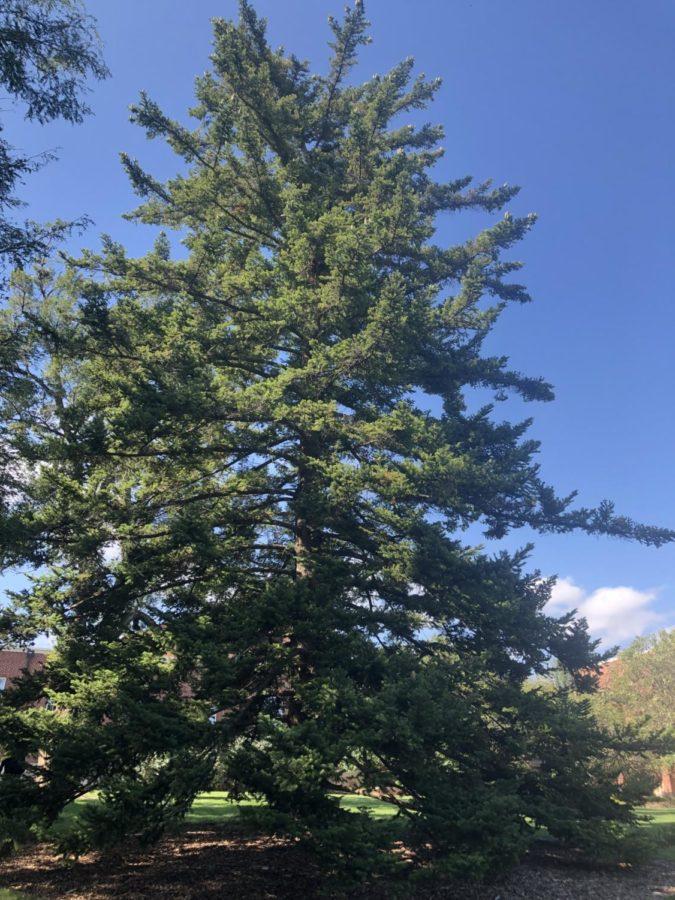Advisory committee discovers rare tree on campus
Logan Metzger/ Iowa State Daily
This rare fir tree is a hybrid of the Greek and Spanish fir tree varieties. It was discovered by the tree advisory committee while they were out on their annual tree walk.
October 6, 2019
Iowa State is well known for its beautiful campus, from Lake Laverne to Reiman Gardens. Recently it was discovered that one small part of the campus landscape is actually a rare hybrid.
“We are sort of identified with our campus,” said Rhonda Martin, landscape architect for facilities planning and management. “Our campus has gotten some awards for being very beautiful and that is about the landscape with the trees. You come here and you know right away you are on a campus that appreciates trees; you walk out onto central campus and you know we love our trees.”
One large fir tree, which resides on the Forker Building’s east lawn, is now believed to be a hybrid of the Spanish and Greek fir varieties.
“The horticulturalists and arborists came out here with a plant key,” Martin said. “They used a magnifying glass and looked at the underside of the needles and looked if it had one white stripe or two stripes […] stuff like that is how taxonomy is figured out. This tree fell halfway between two known varieties of fir tree.”
Martin said having a tree like this on campus for this long and finding out that they are able to grow it here is amazing.
“We all talk about the biggest and largest and all that other kind of stuff,” Martin said. “And that’s a nice story, we like to have these big, significant major trees on campus to study, just to admire. Hello, it’s a great tree.”
Finding this tree was not as simple as a random person walking up to it and identifying it. There was a whole committee behind it.
Iowa State joined Tree Campus USA, a program recognizing college and university campuses that effectively manage trees and engage students, almost five years ago. Martin said part of the requirements is to have a tree advisory committee and then have meetings. She said they have meetings in the spring where they discuss things like tree diseases and then they have meetings in the fall where they go on a tree walk around different parts of campus.
“This fall our walk was on the east side of campus,” Martin said. “We got here and I was saying something like ‘This is the biggest fir tree on campus’ and then they got into the discussion of what kind of fir it was and then they had to go figure it out. They like a good plant mystery.”
Martin said the tree advisory committee is made up of people from many different backgrounds who all work together to keep the campus’ trees healthy. They include horticulturalists, arborists, landscape architects, Ames community members, Iowa State students and entomologists.
“We looked at aerial photos and we don’t really know how old it is,” Martin said. “It started showing up in the 1950s; it could be that it was there in the 1940s but the aerial photos aren’t that good. They just aren’t that good so I wasn’t comfortable claiming it is older than it really is, it could be 80 years old but we just don’t know.”
Martin said no one actually knows how the tree even grew where it was.
“We don’t know,” Martin said. “Was it a gift? Did someone propagate it somewhere and say ‘Here I crossed these two things?’ We don’t know. There is no one to go back to to ask.”
She said there’s no record of the tree or where it came from, but the fir hybrid may one day have offspring of its own planted on campus. The horticulture department and campus services teams are exploring the possibility of cultivating its seedlings. But lone tree hybrids such as this one typically have low seed viability, so Martin is unsure of when seedlings will be viable.
Martin said trees are important for many reasons on campus. They are good for mental health, they provide a food source for wildlife and they help cool down hot buildings and sidewalks by providing shade.
















